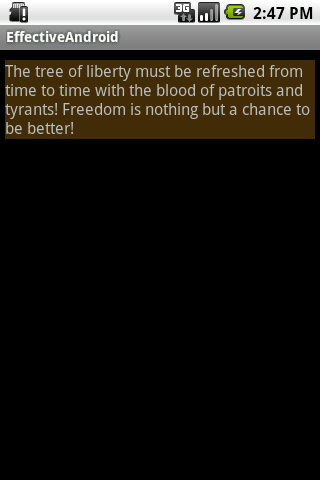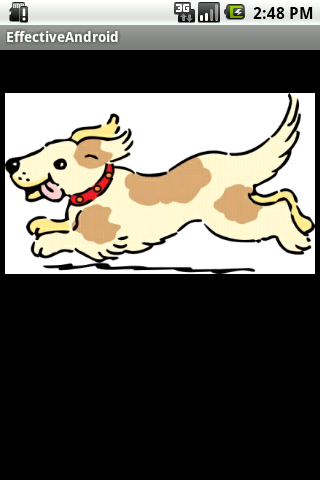Android优化 —— 布局
来源:互联网 发布:三国无双7捏脸数据 编辑:程序博客网 时间:2024/05/17 14:27
ViewStub
在开发应用程序的时候,经常会遇到这样的情况,会在运行时动态根据条件来决定显示哪个View或某个布局。那么最通常的想法就是把可能用到的View都写在上面,先把它们的可见性都设为View.GONE,然后在代码中动态的更改它的可见性。这样的做法的优点是逻辑简单而且控制起来比较灵活。但是它的缺点就是,耗费资源。虽然把View的初始可见View.GONE但是在 inflate 布局的时候View仍然会被 inflate,也就是说仍然会创建对象,会被实例化,会被设置属性。也就是说,会耗费内存等资源。
推荐的做法是使用android.view.ViewStub,ViewStub是一个轻量级的View,它一个看不见的,不占布局位置,占用资源非常小的控件。可以为ViewStub指定一个布局,在 inflate 布局的时候,只有ViewStub会被初始化,然后当ViewStub被设置为可见的时候,或是调用了ViewStub.inflate()的时候,ViewStub所向的布局就会被 inflate 和实例化,然后ViewStub的布局属性都会传给它所指向的布局。这样,就可以使用ViewStub来方便的在运行时,要还是不要显示某个布局。
但ViewStub也不是万能的,下面总结下ViewStub能做的事儿和什么时候该用ViewStub,什么时候该用可见性的控制。
首先来说说ViewStub的一些特点:
ViewStub只能 inflate 一次,之后ViewStub对象会被置为空。按句话说,某个被ViewStub指定的布局被 inflate 后,就不会够再通过ViewStub来控制它了。ViewStub只能用来 inflate 一个布局文件,而不是某个具体的View,当然也可以把View写在某个布局文件中。
基于以上的特点,那么可以考虑使用ViewStub的情况有:
在程序的运行期间,某个布局在 inflate 后,就不会有变化,除非重新启动。因为
ViewStub只能 inflate 一次,之后会被置空,所以无法指望后面接着使用ViewStub来控制布局。所以当需要在运行时不止一次的显示和隐藏某个布局,那么ViewStub是做不到的。这时就只能使用View的可见性来控制了。想要控制显示与隐藏的是一个布局文件,而非某个
View。因为设置给ViewStub的只能是某个布局文件的id,所以无法让它来控制某个View。所以,如果想要控制某个View(如Button或TextView)的显示与隐藏,或者想要在运行时不断的显示与隐藏某个布局或View,只能使用View的可见性来控制。
下面来看一个实例
在这个例子中,要显示二种不同的布局,一个是用TextView显示一段文字,另一个则是用ImageView显示一个图片。这二个是在onCreate()时决定是显示哪一个,这里就是应用ViewStub的最佳地点。
先来看看布局,一个是主布局,里面只定义二个ViewStub,一个是为显示文字做的TextView布局,一个是为ImageView而做的布局:
<?xml version="1.0" encoding="utf-8"?> <LinearLayout xmlns:android="http://schemas.android.com/apk/res/android" android:orientation="vertical" android:layout_width="fill_parent" android:layout_height="fill_parent" android:gravity="center_horizontal"> <ViewStub android:id="@+id/viewstub_demo_text" android:layout_width="wrap_content" android:layout_height="wrap_content" android:layout_marginLeft="5dip" android:layout_marginRight="5dip" android:layout_marginTop="10dip" android:layout="@layout/viewstub_demo_text_layout"/> <ViewStub android:id="@+id/viewstub_demo_image" android:layout_width="wrap_content" android:layout_height="wrap_content" android:layout_marginLeft="5dip" android:layout_marginRight="5dip" android:layout="@layout/viewstub_demo_image_layout"/></LinearLayout>TextView的布局:
<?xml version="1.0" encoding="utf-8"?><LinearLayout xmlns:android="http://schemas.android.com/apk/res/android" android:orientation="vertical" android:layout_width="wrap_content" android:layout_height="wrap_content"> <TextView android:id="@+id/viewstub_demo_textview" android:layout_width="fill_parent" android:layout_height="wrap_content" android:background="#aa664411" android:textSize="16sp"/></LinearLayout>ImageView的布局:
<?xml version="1.0" encoding="utf-8"?><LinearLayout xmlns:android="http://schemas.android.com/apk/res/android" android:orientation="vertical" android:layout_width="wrap_content" android:layout_height="wrap_content"> <ImageView android:id="@+id/viewstub_demo_imageview" android:layout_width="wrap_content" android:layout_height="wrap_content"/></LinearLayout>下面来看代码,决定来显示哪一个,只需要找到相应的ViewStub然后调用其infalte()就可以获得相应想要的布局:
package com.effective;import android.app.Activity;import android.os.Bundle;import android.view.ViewStub;import android.widget.ImageView;import android.widget.TextView;public class ViewStubDemoActivity extends Activity { @Override public void onCreate(Bundle savedInstanceState) { super.onCreate(savedInstanceState); setContentView(R.layout.viewstub_demo_activity); if ((((int) (Math.random() * 100)) & 0x01) == 0) { // to show text // all you have to do is inflate the ViewStub for textview ViewStub stub = (ViewStub) findViewById(R.id.viewstub_demo_text); stub.inflate(); TextView text = (TextView) findViewById(R.id.viewstub_demo_textview); text.setText("The tree of liberty must be refreshed from time to time" + " with the blood of patroits and tyrants! Freedom is nothing but " + "a chance to be better!"); } else { // to show image // all you have to do is inflate the ViewStub for imageview ViewStub stub = (ViewStub) findViewById(R.id.viewstub_demo_image); stub.inflate(); ImageView image = (ImageView) findViewById(R.id.viewstub_demo_imageview); image.setImageResource(R.drawable.happy_running_dog); } }}运行结果: 

注意事项:
某些布局属性要加在ViewStub而不是实际的布局上面,才会起作用,比如上面用的android:layout_margin*系列属性,如果加在TextView上面,则不会起作用,需要放在它的ViewStub上面才会起作用。而ViewStub的属性在inflate()后会都传给相应的布局。
参考链接:http://blog.csdn.net/hitlion2008/article/details/6737537/
- Android优化 —— 布局
- android性能优化——布局优化
- Android性能优化——布局优化
- Android 性能优化——布局优化
- Android性能优化系列—布局优化
- Android性能优化—布局优化技巧
- Android布局优化——抽象布局:include、merge 、ViewStub
- 为Android性能优化——布局优化
- Android性能优化(1) ——布局优化
- Android优化(一)——布局优化
- 【Android性能优化(一)】—— 布局优化
- Android性能优化调研——UI布局优化
- Android性能优化 —— 布局优化篇
- Android优化--布局优化
- Android——Android布局优化(include、ViewStub、merge)
- Android最佳性能实践(四)——布局优化技巧
- Android最佳性能实践——布局优化技巧
- Android最佳性能实践(四)——布局优化技巧
- 对电子游戏的平衡性和可玩性的直观感受和对游戏生涯的憧憬
- java实现链表及其相关操作
- 51Nod-1557-两个集合
- 基本的HTTP流程有哪些
- 最高效的oracle分页语句,你会了吗?
- Android优化 —— 布局
- MOOC 简单的整数划分问题
- 大二下,新的开始
- test
- 设计模式——工厂模式
- 深入掌握 ECMAScript 6 异步编程(四):async函数的含义与用法
- Html5 学习系列(六)Html5本地存储和本地数据库
- 单调递增最长子序列
- 随机数


